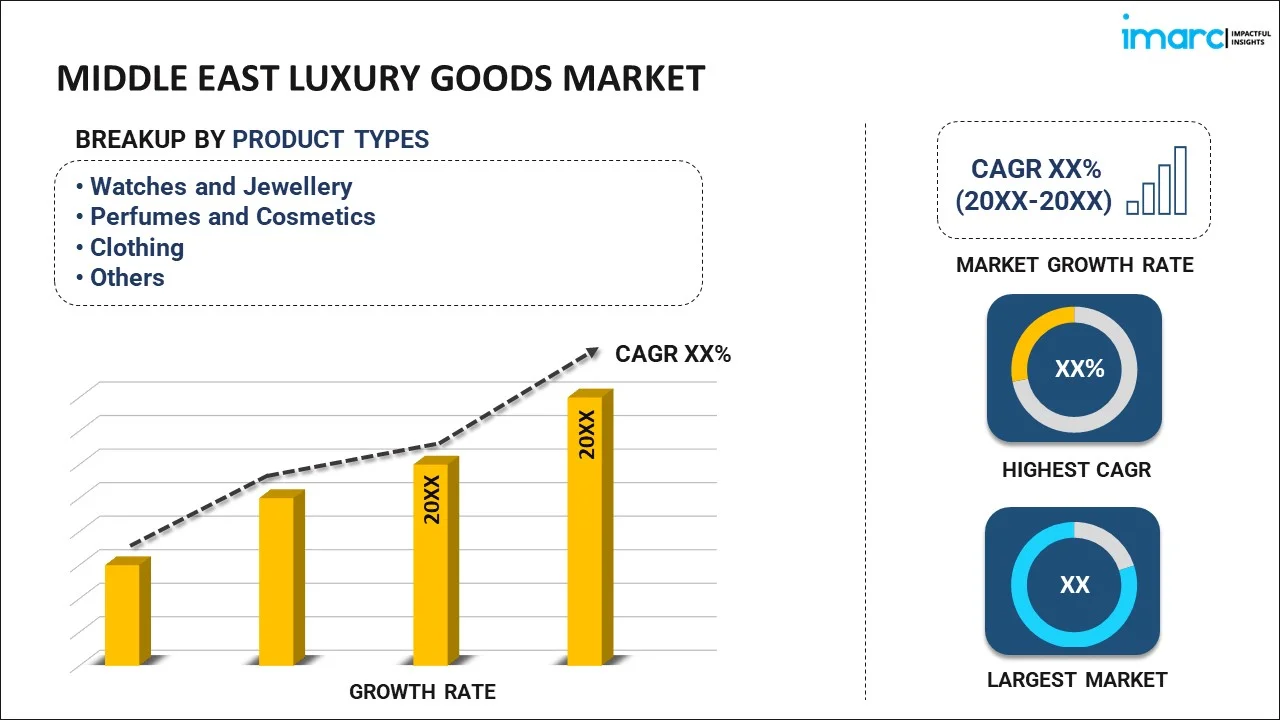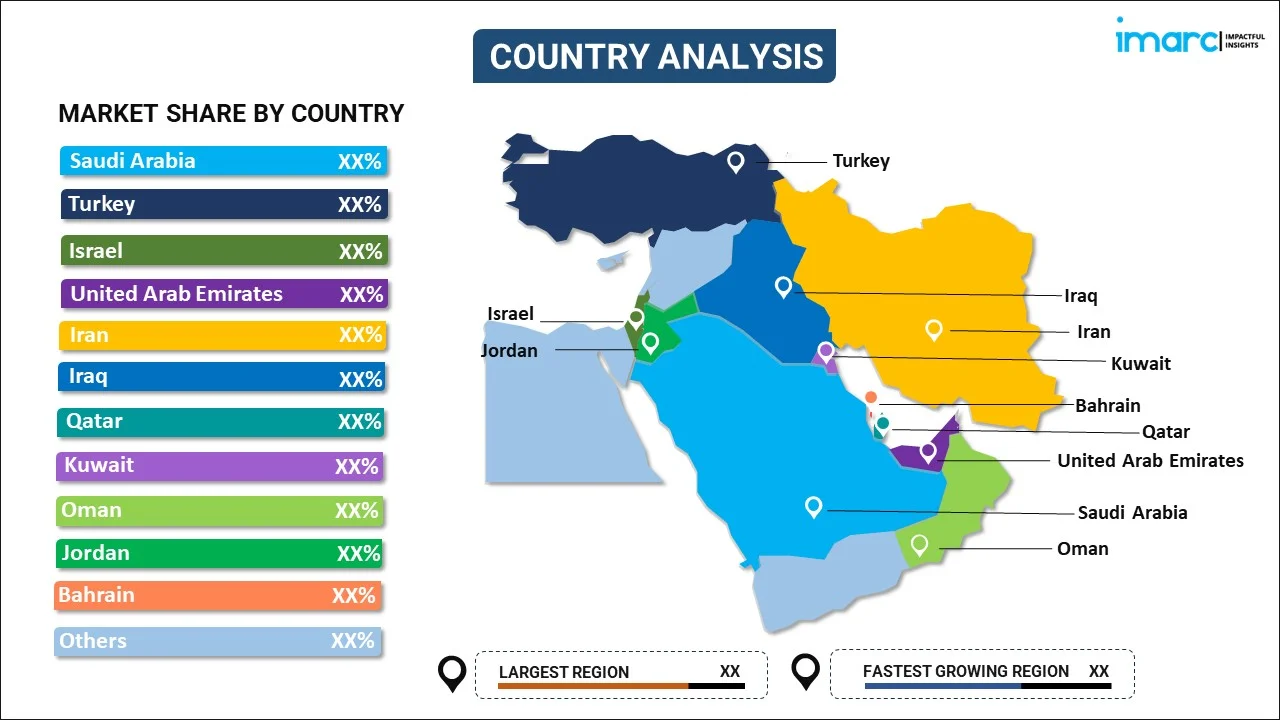
Middle East Luxury Goods Market Report by Product Type (Watches and Jewellery, Perfumes and Cosmetics, Clothing, Bags/Purse, and Others), Distribution Channel (Offline, Online), End User (Women, Men), and Country 2025-2033
Market Overview:
Middle East luxury goods market size is projected to exhibit a growth rate (CAGR) of 5.32% during 2025-2033. The increasing demand for e-commerce platforms and the digital presence of luxury brands, which are essential components for engaging with a broader audience, are driving the market.
|
Report Attribute
|
Key Statistics
|
|---|---|
|
Base Year
|
2024 |
|
Forecast Years
|
2025-2033
|
|
Historical Years
|
2019-2024
|
| Market Growth Rate (2025-2033) | 5.32% |
Luxury goods embody a blend of exquisite craftsmanship, abundant materials, and a distinct aura of exclusivity, transcending mere functionality to become symbols of prestige and refinement. These items, ranging from high-end fashion and accessories to lavish automobiles and premium timepieces, are crafted with meticulous attention to detail, often by skilled artisans. The allure of luxury lies not only in the superior quality of materials but also in the associated lifestyle and status. Luxury goods cater to a discerning clientele who appreciate the artistry and heritage embedded in each creation. Beyond mere possessions, these items signify a commitment to excellence and a celebration of individuality. In a world driven by mass production, luxury goods offer a respite, inviting consumers to embrace a unique experience that goes beyond the ordinary, creating a realm where elegance and sophistication intertwine.
Middle East Luxury Goods Market Trends:
The luxury goods market in the Middle East is experiencing robust growth, driven by a confluence of factors. Firstly, the rising disposable income has propelled consumer spending on luxury items. This trend is further accentuated by an increasing number of high-net-worth individuals seeking exclusive and prestigious products. Additionally, the growing influence of social media has created a heightened awareness and aspiration for luxury brands, connecting consumers to a world of opulence. Moreover, the expanding middle class in the Middle East has become a pivotal driver as consumers aspire to upgrade their lifestyles with premium products. Furthermore, the evolution of consumer preferences towards experiential luxury, characterized by unique and personalized offerings, has reshaped the market landscape. The convergence of technology and luxury has also played a pivotal role, with e-commerce platforms providing seamless access to high-end products. The emphasis on sustainability and ethical practices has emerged as a key driver, as discerning consumers demand transparency in the production processes of luxury goods. In conclusion, the regional luxury goods market is propelled by a multifaceted interplay of economic prosperity, evolving consumer aspirations, technological integration, and a growing consciousness towards sustainability.
Middle East Luxury Goods Market Segmentation:
IMARC Group provides an analysis of the key trends in each segment of the market, along with forecasts at the regional and country levels for 2025-2033. Our report has categorized the market based on product type, distribution channel, and end user.
Product Type Insights:

- Watches and Jewellery
- Perfumes and Cosmetics
- Clothing
- Bags/Purse
- Others
The report has provided a detailed breakup and analysis of the market based on the product type. This includes watches and jewellery, perfumes and cosmetics, clothing, bags/purse, and others.
Distribution Channel Insights:
- Offline
- Online
A detailed breakup and analysis of the market based on the distribution channel have also been provided in the report. This includes offline and online.
End User Insights:
- Women
- Men
The report has provided a detailed breakup and analysis of the market based on the end user. This includes women and men.
Country Insights:

- Saudi Arabia
- Turkey
- Israel
- United Arab Emirates
- Iran
- Iraq
- Qatar
- Kuwait
- Oman
- Jordan
- Bahrain
- Others
The report has also provided a comprehensive analysis of all the major regional markets, which include Saudi Arabia, Turkey, Israel, United Arab Emirates, Iran, Iraq, Qatar, Kuwait, Oman, Jordan, Bahrain, and Others.
Competitive Landscape:
The market research report has also provided a comprehensive analysis of the competitive landscape. Competitive analysis such as market structure, key player positioning, top winning strategies, competitive dashboard, and company evaluation quadrant has been covered in the report. Also, detailed profiles of all major companies have been provided.
Middle East Luxury Goods Market Report Coverage:
| Report Features | Details |
|---|---|
| Base Year of the Analysis | 2024 |
| Historical Period | 2019-2024 |
| Forecast Period | 2025-2033 |
| Units | Million USD |
| Scope of the Report | Exploration of Historical and Forecast Trends, Industry Catalysts and Challenges, Segment-Wise Historical and Predictive Market Assessment:
|
| Product Types Covered | Watches and Jewellery, Perfumes and Cosmetics, Clothing, Bags/Purse, Others |
| Distribution Channels Covered | Offline, Online |
| End Users Covered | Women, Men |
| Countries Covered | Saudi Arabia, Turkey, Israel, United Arab Emirates, Iran, Iraq, Qatar, Kuwait, Oman, Jordan, Bahrain, Others |
| Customization Scope | 10% Free Customization |
| Post-Sale Analyst Support | 10-12 Weeks |
| Delivery Format | PDF and Excel through Email (We can also provide the editable version of the report in PPT/Word format on special request) |
Key Questions Answered in This Report:
- How has the Middle East luxury goods market performed so far and how will it perform in the coming years?
- What has been the impact of COVID-19 on the Middle East luxury goods market?
- What is the breakup of the Middle East luxury goods market on the basis of product type?
- What is the breakup of the Middle East luxury goods market on the basis of distribution channel?
- What is the breakup of the Middle East luxury goods market on the basis of end user?
- What are the various stages in the value chain of the Middle East luxury goods market?
- What are the key driving factors and challenges in the Middle East luxury goods?
- What is the structure of the Middle East luxury goods market and who are the key players?
- What is the degree of competition in the Middle East luxury goods market?
Key Benefits for Stakeholders:
- IMARC’s industry report offers a comprehensive quantitative analysis of various market segments, historical and current market trends, market forecasts, and dynamics of the Middle East luxury goods market from 2019-2033.
- The research report provides the latest information on the market drivers, challenges, and opportunities in the Middle East luxury goods market.
- Porter's five forces analysis assist stakeholders in assessing the impact of new entrants, competitive rivalry, supplier power, buyer power, and the threat of substitution. It helps stakeholders to analyze the level of competition within the Middle East luxury goods industry and its attractiveness.
- Competitive landscape allows stakeholders to understand their competitive environment and provides an insight into the current positions of key players in the market.
Need more help?
- Speak to our experienced analysts for insights on the current market scenarios.
- Include additional segments and countries to customize the report as per your requirement.
- Gain an unparalleled competitive advantage in your domain by understanding how to utilize the report and positively impacting your operations and revenue.
- For further assistance, please connect with our analysts.
 Inquire Before Buying
Inquire Before Buying
 Speak to an Analyst
Speak to an Analyst
 Request Brochure
Request Brochure
 Request Customization
Request Customization




.webp)




.webp)












